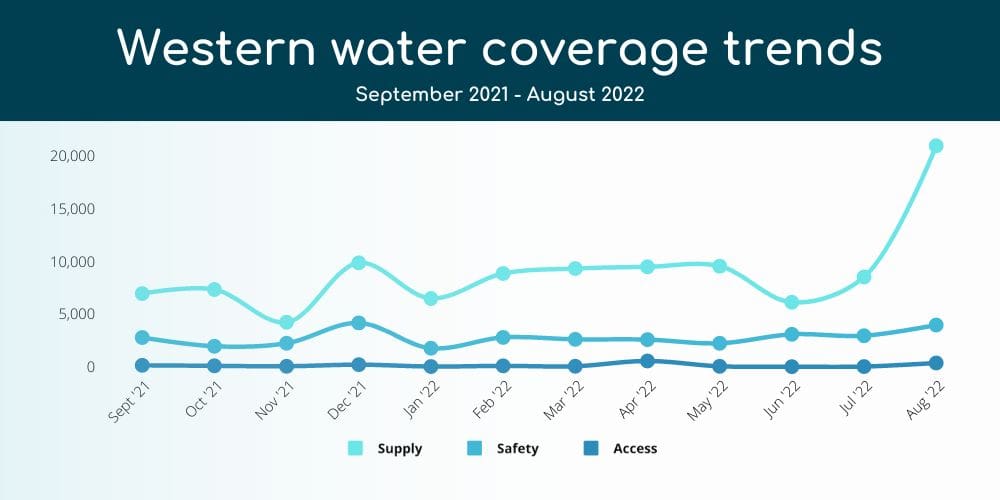Since 2020, the Water Hub has been tracking media coverage trends across three categories: Western water supply, water safety, and access and affordability. These regular reports help us to better understand what’s driving the water news cycle, what issues are popping, and how current events are shaping the way we think about water issues.
We’ve just completed our latest scan, looking at water news from September 2021 through August 2022, and here are some top takeaways:

- We’ve become used to the ebbs and flows of water coverage over the years, following seasons, weather extremes, and snow reports. But, the crises of unsustainable water management and climate change, the overall volume of western water supply news stories continues to increase and our scan is picking up less month-to-month variation. TLDR: Warming temps and megadrought have brought the West’s water crisis to a head, and more reporters are covering the beat than ever. (Case in point: the Colorado River Water Users Association “sold out” of media credentials this year.)
- 3 in 4 western water news stories cover Western water supply, and 40% mention the Colorado River. This increase in water supply news coverage peaked in August, with more than 20,000 news stories in one month alone (compared to 12,000 in August 2021). This spike followed last year’s trend as the Bureau of Reclamation’s announcement of 2023 water cuts was a major media moment for the Colorado River.
- Coverage was dominated by reporting on dire reservoir levels and political positioning, but we also pulled out some of our favorite solutions stories this past year. Examples include Christian Science Monitor’s look into rural New Mexico’s acequia culture, 50 years of citizen science studying snowpack from a high-elevation ghost town, a deep dive into water recycling from Southern California to Colorado, wiser water use in wine country and the Las Vegas ban on ornamental grass.
- While the overall volume of water-related news stories in the West is growing, the past bump in attention we observed to water access and public health in relation to the pandemic have not continued. However, the passage of the Infrastructure Investment and Jobs Act in November 2021 was big news for rural and Indigenous water access, infusing billions of Tribal clean water funding to the Indian Health Service’s water and sanitation program.
- Drinking water is the top frame for water safety coverage in this scan, and contamination of water supplies drove media coverage. The largest wildfires in New Mexico’s history contaminated the Gallinas River and the drinking water supply for the city of Las Vegas, NM, an audit of California’s SAFER program found 1 million people in the state still lack access to safe drinking water, and the EPA identified over 120,000 locations contaminated with PFAS.
- From stories on the science, like the worst megadrought in 1,200 years, to how farmers are responding to climate impacts (and investing in new water-efficient ways of doing business), the majority of Western water news coverage is considering climate change, and how the impacts and our response are shaping the future of water.
These are just a few highlights! You can read the full media scan here. Please don’t hesitate to reach out to suggest specific issues we can monitor and analyze in our next report!